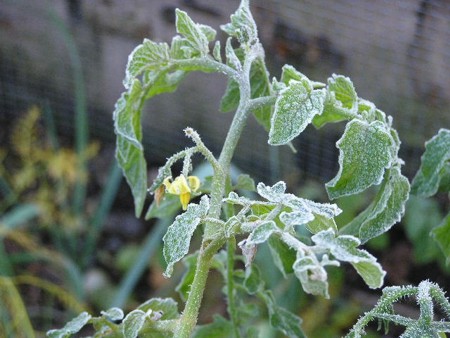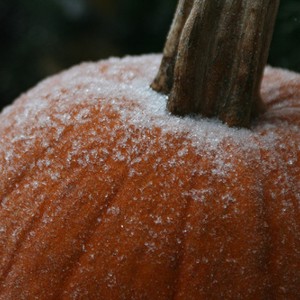If you haven’t already had hard frost in your part of the north, it’s coming soon. Maybe tonight! So, it’s time to take a good long look at your beloved, bounteous garden and decide what to do with what’s left out there. And that includes what’s left behind after the crop is picked and brought in!
 If your Tomatoes look like this on Tuesday morning…
If your Tomatoes look like this on Tuesday morning…
 …They’ll look like this by Thursday afternoon.You can salvage the fruit,
…They’ll look like this by Thursday afternoon.You can salvage the fruit,
but it won’t develop or ripen any further. Fried Green Tomatoes, anyone?
Okay…
The first things to go will be the soft plants – Tomatoes, Peppers and soft Herbs such as Basil, Cilantro and Parsley. They’re totally done when you come out one morning and the leaves – though they may still look a healthy green – are either covered with frost or (later in the day) droopy and damp. You may still be able to salvage any green tomatoes still on the vine, but the aforementioned Herbs and Peppers will be damaged beyond redemption.
Got Onions or Garlic? Take them in now. And consider harvesting your remaining hard Herbs – Oregano, Thyme, Sage and Rosemary, for instance – before a really hard frost ensues. They won’t grow much more at this late time of year, anyway. Same goes for your Winter Squashes (including Pumpkins) and Cucumbers.
Potatoes, Parsnips, Carrots and other root veggies can be left in the ground until the soil freezes. You’ll want to store them in a cool/cold dark place, just like underground, anyway, if they’re to last through the winter! If you’ve grown Potatoes before, you’ll probably already know that it’s standard practice to leave them in the ground until the tops have browned off, in any case.
Your perennial Berries and Rhubarb have, of course, been done for the season long ago. Now is the time to mound up around their roots to protect against winter damage.
What about the detritus?
You have the option of mulching in all the dead, barren vines, stems and other bits left over in the garden after the harvest – or collecting them and adding them to your compost pile for a more organized recycling treatment. Whatever you do, don’t just cut them down and bag them as yard waste! They’ll enrich your garden’s soil, add fibrous material to help break up dense, hard soils, and provide, in their decomposition, a generous, nurturing habitat for beneficial microorganisms!
You are what you eat!
Love your garden, love yourself!
~ Maggie J.

